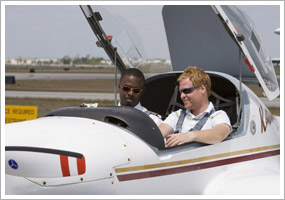| The following stories from the May 22, 2009, edition of AOPA ePilot were provided to AOPA members who expressed an interest in the particular subject areas. Any AOPA member can receive information tailored to their areas of interest by updating their preferences online. TRAINING TIPsLearning style
AOPA Flight Training Associate Editor Jill W. Tallman corresponded with the student pilot and recognized the value of the latter’s effort. “It never occurred to me, back then in primary training, to try to figure out what type of learning style I had,” said Tallman, an instrument-rated private pilot. “Now I know, and when I get instruction I make sure to ask the CFI to demonstrate it first so that I can see … what we're supposed to be accomplishing.” Had she done that at the outset, “it might not have taken me so long to get some things—soft-field takeoffs, for example,” Tallman said.
Not sure what kind of learner you are? Check out Chapter 2 of The Aviation Instructor’s Handbook , which describes learning styles and the traits associated with them (Figure 2-15). The text provides instructors with teaching tips for learners with various styles. Also see Chapter 8 of AOPA’s Guide to Learning to Fly for 10 tips for evaluating an instructor.
AOPA Flight Training columnist and CFI Rod Machado recalled a teachable moment—one that gave him new appreciation for learning styles. A disagreement over footwear taught Machado the importance of adapting to a student's learning preferences. “That was more than 20 years ago, and I still remember the lesson I learned. Marty tried to teach me how to teach him, but I wasn't paying attention. Since then, I actively try to find out how a student prefers to be taught.” He also has advice for students: “For (instructors) to understand your learning preferences, you must tell them.” TRAINING PRODUCTSLow-cost headset from Marv GoldenNeed a new headset, but the budget is tight? Marv Golden’s Golden Eagle model weighs just 12 ounces and offers a noise reduction rating of 24 decibels. And it comes with a free bag. The headset sells for $79 and can be ordered online or by calling 800/348-0014. For tips on buying a headset, see the guide on AOPA Flight Training Online. |
 A recent letter to AOPA from a student pilot in Wisconsin pointed out the importance of adjusting to a trainee's learning style. Resuming flight training after months of inactivity, the student pilot called a conference with her CFI to make sure that the instructor understood her learning style.
A recent letter to AOPA from a student pilot in Wisconsin pointed out the importance of adjusting to a trainee's learning style. Resuming flight training after months of inactivity, the student pilot called a conference with her CFI to make sure that the instructor understood her learning style.

